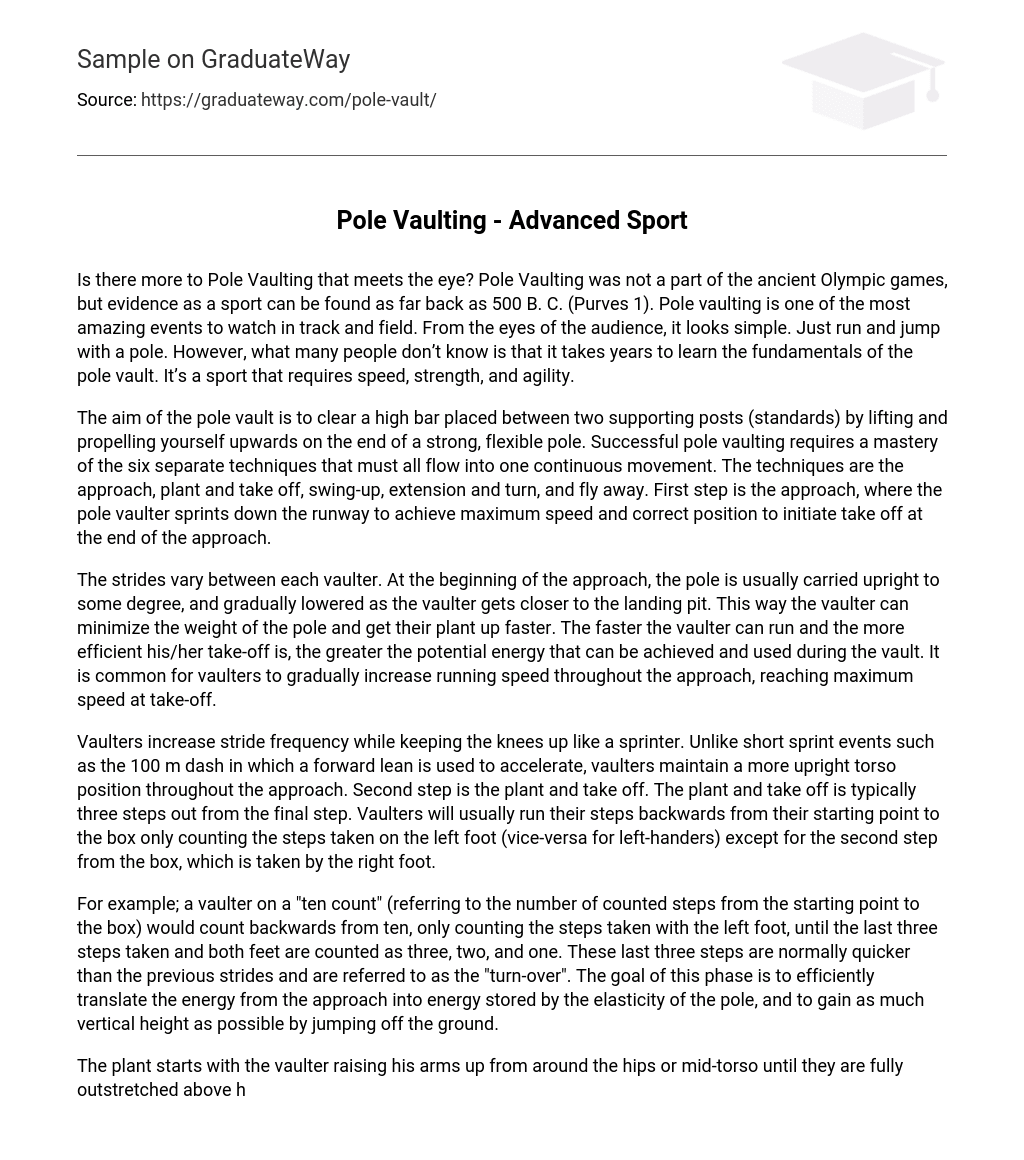Pole Vaulting, a sport that dates back to 500 B.C., was not a part of the ancient Olympic games. However, it remains as one of the most fascinating events in track and field. From an audience perspective, the act of running and jumping with a pole seems simple. However, the truth is that mastering the fundamentals of pole vaulting takes years of practice. This sport demands a combination of speed, strength, and agility.
The objective of the pole vault is to raise a high bar placed between two supporting posts (standards) by using a strong, flexible pole to lift and propel oneself upwards. Achieving successful pole vaulting requires mastering six distinct techniques that seamlessly flow together as one continuous motion. These techniques include the approach, plant and take off, swing-up, extension and turn, and fly away. The initial stage is the approach, where the pole vaulter sprints down the runway to attain maximum speed and proper positioning for initiating take off at the conclusion of the approach.
The pole is carried upright at the beginning of the approach and gradually lowered as the vaulter gets closer to the landing pit. This allows for minimizing the weight of the pole and a faster plant. The vaulter’s running speed and take-off efficiency determine the potential energy achieved and used during the vault. Vaulters typically increase running speed throughout the approach, reaching maximum speed at take-off.
Vaulters increase their stride frequency while keeping their knees up, similar to a sprinter. However, unlike short sprint events like the 100m dash where a forward lean is used to accelerate, vaulters maintain a more upright torso position throughout their approach. The second step, known as the plant and take off, occurs approximately three steps away from the final step. When running towards the box, vaulters typically count their steps backwards from their starting point, only considering the steps taken on their left foot (or right foot for left-handers). The only exception is the second step from the box, which is taken using the right foot.
One example is a vaulter who uses a “ten count” to measure their steps from the starting point to the box. They count backwards from ten, only including steps taken with the left foot. However, the last three steps are counted as three, two, and one, as they are quicker and known as the “turn-over”. During this phase, the vaulter aims to effectively convert energy from the approach into energy stored by the pole’s elasticity. The goal is also to maximize vertical height by propelling off the ground.
The vaulter initiates the plant by raising their arms from the hips or mid-torso until they are fully extended above the head, with the right arm above the head and the left arm perpendicular to the pole (opposite for left-handed vaulters). Simultaneously, the vaulter lowers the pole tip into the box. On the last step, the vaulter jumps off the trail leg (left for right-handed vaulters and vice versa for left-handed vaulters), keeping it straight, and propels the front knee forward.
As the pole is inserted into the box, it starts to bend while the vaulter moves upwards and forwards, with their trail leg angled downwards and behind them. The fourth step involves extending and twisting. The extension involves pushing up the hips with straightened legs and lowering the shoulders, resulting in the vaulter being positioned upside down, commonly known as “inversion”. During this step, the pole begins to recoil, propelling the vaulter upwards rapidly.
The vaulter keeps their hands close to their body as they move from the shins to the hips and upper torso, and then they start to turn. This turn happens right after the extension, with the vaulter turning towards the pole while extending their arms past their head and shoulders. Usually, the vaulter will also angle their body towards the bar as they do the turn, but the goal is to remain as vertical as possible. The last step is the fly away, which is the simplest part of the pole vault.
During this stage, the vaulter focuses on pushing off the pole and letting go, causing it to fall away from the bar and mats. As the vaulter’s body clears the bar, they face towards it. The rotation of the body over the bar happens effortlessly, with the main priority being to avoid hitting the bar with any body parts, such as the arms or face. For a successful landing, the vaulter aims to land in the middle of the pit, facing upwards, and with their back touching the mats.
The vault has been a part of the Olympic Games since the first modern Games in 1896 (Purves 1). It is considered one of the most fascinating events in track and field. Many people mistakenly believe that the vault simply involves running with a pole to jump over another, but there is much more to it. This sport demands speed, strength, and agility, as well as mastery of several technical skills including the approach, plant and take off, swing-up, extension and turn, and fly away.





